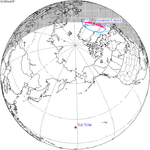Solar eclipse of June 11, 2086
Appearance
| Solar eclipse of June 11, 2086 | |
|---|---|
| Type of eclipse | |
| Nature | Total |
| Gamma | −0.7215 |
| Magnitude | 1.0174 |
| Maximum eclipse | |
| Duration | 108 s (1 min 48 s) |
| Coordinates | 23°12′S 12°30′E / 23.2°S 12.5°E |
| Max. width of band | 86 km (53 mi) |
| Times (UTC) | |
| Greatest eclipse | 11:07:14 |
| References | |
| Saros | 148 (25 of 75) |
| Catalog # (SE5000) | 9701 |
A total solar eclipse will occur on June 11, 2086. A solar eclipse occurs when the Moon passes between Earth and the Sun, thereby totally or partly obscuring the image of the Sun for a viewer on Earth. A total solar eclipse occurs when the Moon's apparent diameter is larger than the Sun's, blocking all direct sunlight, turning day into darkness. Totality occurs in a narrow path across Earth's surface, with the partial solar eclipse visible over a surrounding region thousands of kilometres wide.
Related eclipses
Solar eclipses 2083-2087
This eclipse is a member of a semester series. An eclipse in a semester series of solar eclipses repeats approximately every 177 days and 4 hours (a semester) at alternating nodes of the Moon's orbit.[1]
| Solar eclipse series sets from 2083 to 2087 | ||||
|---|---|---|---|---|
| Descending node | Ascending node | |||
| 118 | July 15, 2083 Partial |
123 | January 7, 2084 Partial | |
| 128 | July 3, 2084 Annular |
133 | December 27, 2084 Total | |
| 138 | June 22, 2085 Annular |
143 | December 16, 2085 Annular | |
| 148 | June 11, 2086 Total |
153 | December 6, 2086 Partial | |
| 158 | June 1, 2087 Partial | |||
Notes
- ^ van Gent, R.H. "Solar- and Lunar-Eclipse Predictions from Antiquity to the Present". A Catalogue of Eclipse Cycles. Utrecht University. Retrieved 6 October 2018.
References
- Earth visibility chart and eclipse statistics Eclipse Predictions by Fred Espenak, NASA/GSFC
Wikimedia Commons has media related to Solar eclipse of 2086 June 11.




